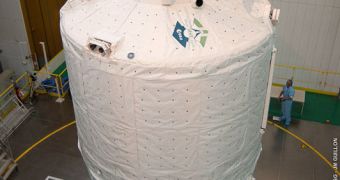At 04:34 GMT (05:34 CET) this Friday, March 23, the third European Automated Transfer Vehicle (ATV-3) will lift off from its dedicated launch pad, at the Kourou Spaceport, in French Guiana, South America. The new resupply mission is bound for the International Space Station (ISS).
The spacecraft and its carrier rocket will be rolled to their pad today, March 21. The maneuver will give European Space Agency (ESA) engineers a couple of days to test the vehicles further, and ensure that everything is set.
Originally, the spacecraft was supposed to launch a few weeks back, but tests revealed a problem with some of its cargo. Apparently, some of the supplies the unmanned capsule carries were poorly secured inside the pressurized container.
This would have posed a safety risk during ascent, so ESA engineers had to take everything out, and then repack it according to very tight specifications. Now that everything is secured, the spacecraft has finally been deemed ready for lift-off.
The decision was made during a formal Launch Readiness Review, which took place this Monday. Mission controllers were unable to find anything wrong with either ATV-3, or the Ariane 5 heavy-lift delivery system that will take it to low-Earth orbit.
Interestingly, this is the heaviest cargo that the Ariane 5 ever had to deliver to space thus far. ATV-3 weighs in excess of 777 tons, a weight that can put a strain on even the most solid rockets. However, the Arianespace vehicle has an excellent track record in a variety of missions.
The European ATV are the largest capsules currently servicing the ISS. They exceed both Russian-built Soyuz and Progress spacecraft, and the Japanese H-II Transfer Vehicles (HTV), in terms of both capacity and size.
Now that the United States has retired its space shuttles, it falls to ESA, the Russian Federal Space Agency (RosCosmos) and the Japan Aerospace Exploration Agency (JAXA) to resupply the station.
Only Russian Soyuz capsules can deliver astronauts to the orbital facility at this point.

 14 DAY TRIAL //
14 DAY TRIAL //